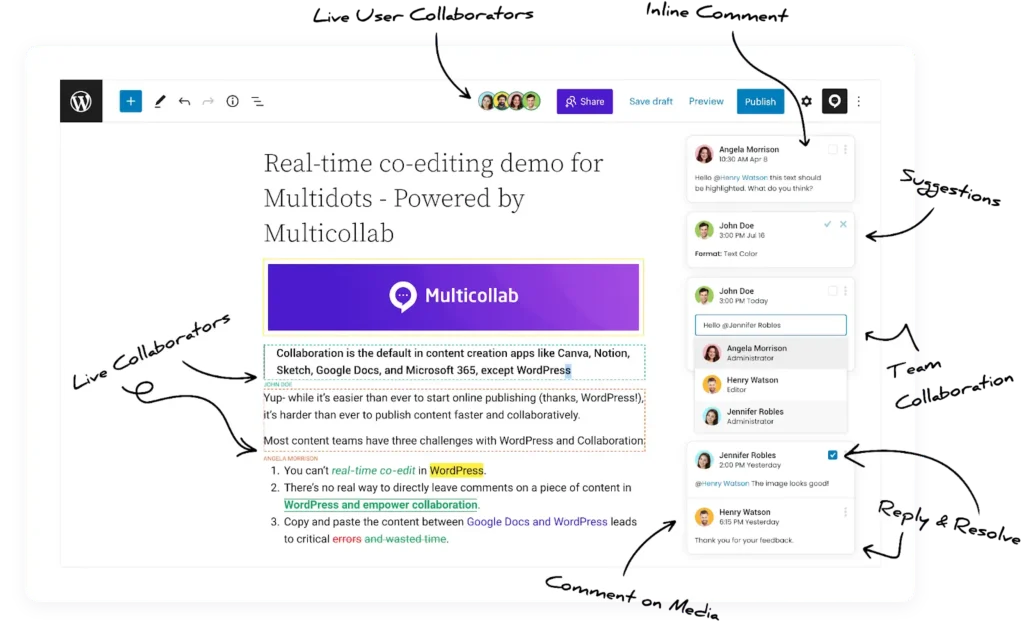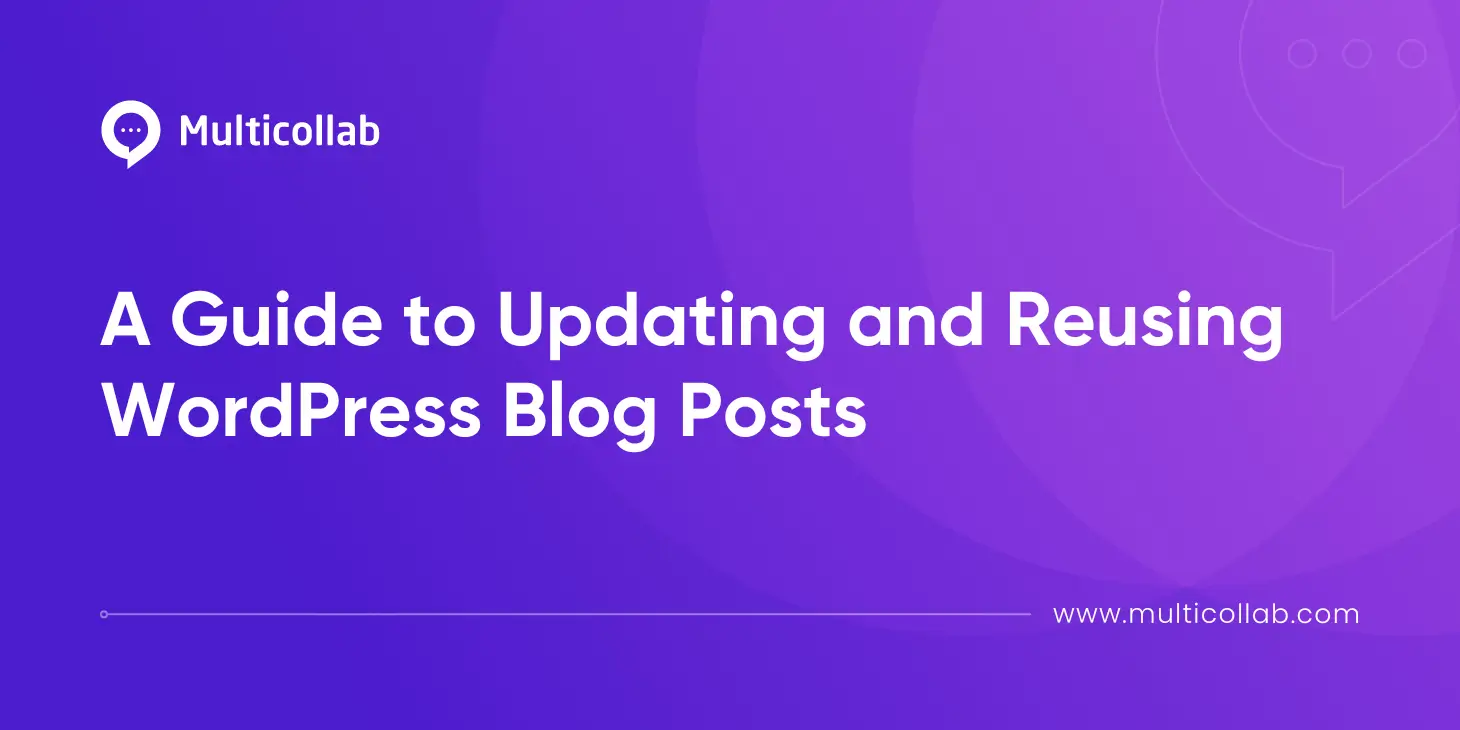Table of Contents
Your WordPress blog is a powerful asset, but over time, even the best content can become outdated or less effective. Instead of letting old blog posts fade into obscurity, why not give them a new lease on life?
Revamping old content is one of the most efficient ways to drive traffic, enhance SEO, and maintain relevance. In this comprehensive guide, we’ll dive into why refreshing your old WordPress content is crucial, provide step-by-step instructions, share expert tips, recommend must-have WordPress plugins, and show how tools like Multicollab can streamline the entire process.
Why Should You Update Old Content?
Imagine this: two years ago, you wrote a killer blog post. It drove tons of traffic, earned engagement, and got you valuable backlinks. But now, it’s outdated. Does that mean its value is lost forever? Not at all.
Take the example of a post titled “Best Social Media Strategies for 2019” Social media strategies evolve rapidly, so a 2019 article is now outdated. However, by updating it to “Best Social Media Strategies for 2024,” with fresh data and examples, you instantly make the content relevant and appealing again.
Maximize Existing Assets: You’ve already invested time and effort into creating your older posts. Refreshing them allows you to capitalize on that investment without starting from scratch.
SEO Benefits: Search engines love fresh, updated content. When you update a blog post, Google views it as new content, potentially boosting its ranking.
Boost Conversion Rates: Optimized, updated posts that reflect the latest trends are more likely to engage users and convert them into leads or customers.
Enhance User Experience: Information changes, trends evolve, and what was relevant three years ago may no longer serve your audience. Updating old posts ensures your readers get the most accurate, valuable information.
Save Time: Updating content is faster than creating something new. You don’t have to start from scratch but still reap the benefits of fresh content.
Step-by-Step Guide to Updating Your Old WordPress Blog Posts
Step 1: Audit Your Content
The first step in revamping old posts is conducting a content audit to identify which posts are worth updating, merging, or removing.
Use Google Analytics: Identify posts that are still generating traffic but could perform better with an update.
Check Search Console: Look for posts that rank in positions 5-20 on Google. These posts are prime candidates for a content refresh that could push them to page 1.
Examine Backlink Profiles: Posts with strong backlinks may just need a bit of an SEO boost to rank higher.
Identify Evergreen Content: Find posts that are not tied to time-sensitive topics. These are great for repurposing and refreshing.
Step 2: Optimize Content for SEO
Once you’ve selected the posts to update, the next step is SEO optimization. This is where you take advantage of the latest SEO trends and algorithm updates.
- Use tools like Ahrefs, SEMrush, or Google Keyword Planner to find new, relevant keywords.
- Target long-tail keywords for quicker rankings.
- Refresh your meta titles and descriptions with updated keywords and current search trends.
- Add internal links to newer posts that relate to the updated content. This boosts both SEO and user experience.
- Rewrite parts of the content to aim for featured snippets, especially with listicles or step-by-step guides.
If your original blog on “SEO Best Practices for 2021” focused on traditional SEO tactics, update it with newer trends like voice search optimization, user experience signals, or AI-driven SEO.
Step 3: Refresh Content for Readability and Engagement
Readability impacts both user engagement and SEO performance and is a huge part of your content creation process. Make your posts more engaging by:
- Adding more headers, subheaders, and bullet points for improved skimmability.
- Replacing outdated images with fresh visuals, infographics, or videos. Tools like Canva can help create new visuals quickly.
- Incorporating interactive elements like polls, quizzes, or embedded videos to boost engagement.
- Updating or adding CTAs to guide readers to the next step, such as signing up for a newsletter or downloading an eBook.
Step 4: Repurpose Content
To maximize the reach of your updated blog post, consider repurposing it into different formats:
Create an Infographic: Summarize key points of your blog into an infographic.
Turn it Into a Video: Convert the blog into a short YouTube video or tutorial.
Podcast: If you run a podcast, discuss the key points of your blog post as an episode.
Social Media Snippets: Share bite-sized insights from the updated post on social media to drive traffic back to your blog.
A long-form blog post on “SEO for Beginners” could be repurposed into a 5-minute YouTube video, an infographic for Pinterest, and a series of tweets highlighting key points.
Step 5: Promote Your Updated Content
After updating your content, don’t forget to promote it! Share it across your social channels, in newsletters, and on forums where it’s relevant.
- Let your newsletter subscribers know about the updated content.
- Share the updated post with a fresh new caption and visuals.
- Contact blogs or websites that previously linked to your content and inform them of the update.
For instance, if your old post on SEO was picked up by a marketing forum two years ago, reach out to that forum again, notifying them of the updated post. They may feature it again.
Step 6: Evaluate Success After Updating
Once you’ve revamped your content, don’t just set it and forget it! Use Google Analytics to track your post’s performance. Look at metrics like increased page views, lower bounce rates, and longer average session duration to evaluate the success of your updates.
Recommended WordPress Plugins for Content Optimization
Yoast SEO: For comprehensive SEO optimization, including keyword updates, readability checks, and meta description optimization.
Broken Link Checker: Automatically scans your site for broken links, ensuring that all internal and external links in your posts are working and SEO-friendly.
WP Rocket: Improves your site’s load speed by optimizing page caching, images, and file compression—an essential step when updating older posts.
WP Revision Master: Helps you track changes in your content as you update posts, making sure you don’t lose any previous edits.
Redirection: Useful for setting up redirects if you change any URLs during the revamping process.
How Multicollab Can Transform Your Content Revamping Process?
One of the most time-consuming aspects of updating content is collaboration. This is where Multicollab can revolutionize your workflow.

Imagine a marketing team at a mid-size company needing to update its content for a new product launch. With Multicollab, the content team can simultaneously work on the ‘Top Digital Marketing Trends 2020’ blog post, each contributor leaving inline comments like ‘let’s add a case study here’ or ‘update this section with current data.’ The process, which used to take weeks with back-and-forth emails and document versions, is now completed within days—right inside WordPress.
Real-Time Collaboration: Multicollab allows multiple contributors to work on a post simultaneously. Editors, writers, and SEO specialists can leave inline comments, make suggestions, and track changes in real-time.
Inline Commenting: Collaborators can comment on specific parts of the content, which makes the revision process faster and more precise.
Suggestion Mode: Easily propose changes without permanently altering the content, allowing editors to approve or reject suggestions.
Activity Tracking: Keep track of who made what changes, so you always have a record of updates and revisions.
Multicollab is an efficient tool for updating old WordPress blogs by streamlining the collaboration process within the editor itself. This eliminates the need for external communication tools and speeds up the content revamping process. Multicollab ensures that updates are made efficiently, maintaining editorial control while improving workflow, making it the ideal solution for refreshing old blog content.
Refresh Old Blogs and Reconnect with Your Audience
By breathing new life into your old posts, you’re not just updating content; you’re building a long-term strategy that consistently delivers value to your audience. By following the above steps, you can improve search rankings, boost engagement, and offer readers up-to-date, relevant information.
Get started with tools like Multicollab to easily breathe new life into your old WordPress blog posts, drive more traffic, and increase conversions. Remember, every post you update is a chance to reconnect with your audience and deliver renewed value.







